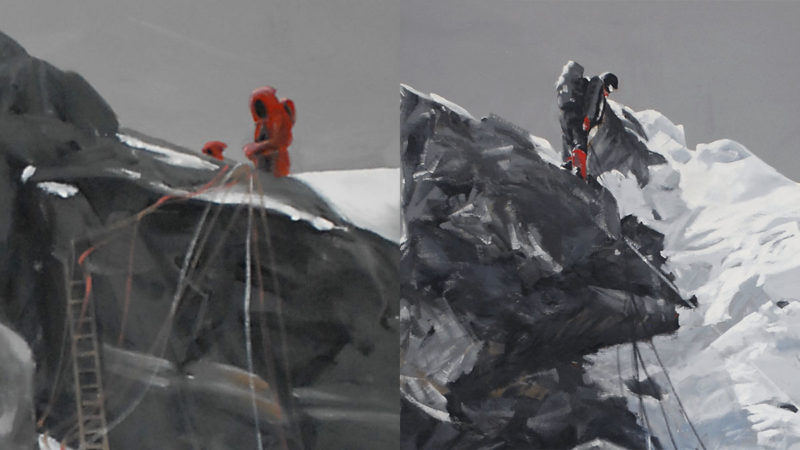This post is also available in: German
Mount Everest has two normal climbing routes. The one from the North, from Tibet, is called Mallory route and uses the Northeast ridge of the mountain. The Northeast ridge has many rocky steps. The first, second and third step are best known.
The second step is located on 8,610 meters (28,250 ft), is hard to climb and can be a deadly trap. It has a climbing height of fourty meters, of which the last five are almost vertical. For this reason a ladder has been fixed there which all tourist climbers use. Most mountaineers would not been able to reach the summit of Mount Everest without this ladder.
Reinhold Messner bought this painting for the sixth Messner Mountain Museum MMM Corones. He ascended solo using the Norman couloir but passed the step on his way down, as he told me.
Climbing History of 2nd Step
The history of this step is subject to many iterations. It is a pity, that there is no “step book”.
As to current knowledge the step was climbed for the first time in 1960, by a Chinese Expedition.
In 1975 another Chinese expedition fixed an aluminium ladder to the step. Almost all climbers used this ladder since.
More often than not climbers have to wait long times before they can use the ladder. These traffic jams impose the serious risk for the climbers to suffer low oxygen or frostbite.
It is reported at wikipedia, that Oscar Cadiach climbed the step free in 1985. He is supposed to have been accompanied by Toni Sors and Carles Vallès. I did not find proof so far, but I am happy to learn!
The ladder has been replaced in 2007 by a new one, also by Chinese mountaineers.
2007, in the same year, the climbers Conrad Anker and Leo Houlding prooved that this obstacle on the north ridge can be free climbed – they removed the stepladder before climbing the second step.
There still is the possibility that the legend George Mallory and Andrew Irvine may have done the same when they tried to climb Mt Everest in 1924.
Second step vs. Hillary step
The Hillary Step is a similar difficulty on the other side of the mountain. A comparison:
Second-Step
Hillary-Step
Northeast ridge
Potentially climbed first by George Leigh Mallory
780 feet (238 meters) below the summit at an altitude of 28,250 feet (8610 meters)
Difficult, UIAA V+, and 130 feet (40 meters) high
Ladder and fixed ropes help
Southeast ridge
Edmund Hillary, Sherpa Norgay Tenzing
300 feet (91,5 meters) below the summit at an altitude of 28729 feet (8756,5 meters)
Medium difficulty, UIAA I-II, and 40 feet (12 meters) high
Fixed ropes help
The three Pinnacles: More Steps on Mt Everest
Three more of the steps on Everest have come to public knowledge as the east face, the Kangshung face, is climbed more frequently.
The Northeast ridge has the three Pinnacles located on 7.800, 8.100 and 8.200 meters before the main climbing route joins it from the North ridge. They offer difficult climbing in the fifth degree. Russell Brice and Harry Taylor mastered them first in 1988.
This painting is part of the set Landmarks of Everest – routes on the mountain shown as paintings. Click here for more!

What about the Chinese Expedition that claims to have ascended the Second Step free, back in 1960? No mention is made of this here.
Thanks for the hint, Kalikiano! Ich will check this and change the post if appropriate! Do you have any sources? Regards, Jürgen
Hi Jurgen,
“Climbers Conrad Anker and Leo Houlding have proven that this obstacle on the north ridge can be free climbed. free climbed Everest’s north ridge. They removed the stepladder before climbing the Second step. Apart from possibility that Mallory and Irvine may had done the same, the two climbers are the first people to have free climbed the notorious second step.”
Please look in to the climb by Oscar Cadiach, Toni Sors and Carles Vallès in 1985. Where they climbed the second free. So far as I am aware this was before Conrad and Leo’s climb.
Greetings,
Tom
Hi Tom,
Thanks for your update. I corrected the article!
Regards, Jürgen
Pingback: The Hillary Step | Jürgen Stäudtner